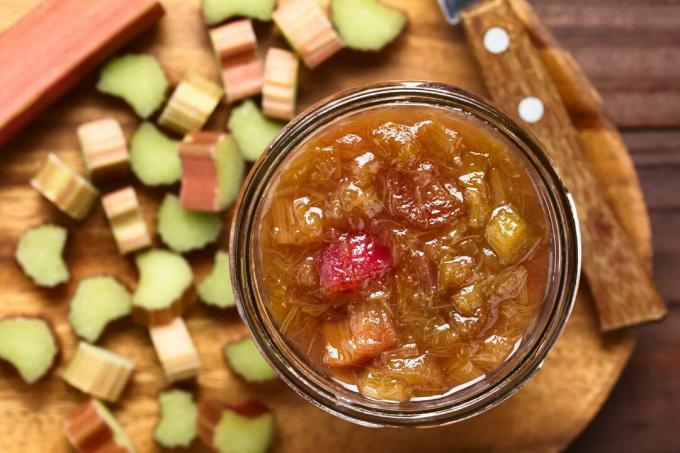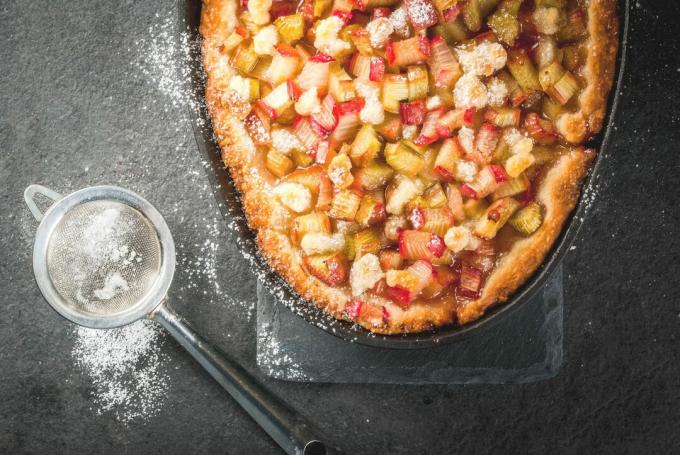Rhubarb can be easily preserved, for example by freezing or boiling. We have collected our tips for you.

rhubarb (Rheum rhabarbarum) tastes simply delicious in many variations and can also be made long-lasting with a few tips. The freshly harvested rhubarb stalks can be kept for up to a week, but become increasingly difficult to peel with increasing age. Wrapped in damp kitchen towels and placed in the refrigerator, the rhubarb stalks can even be kept for up to two weeks. Nevertheless, it is advisable to only harvest as much as you need at the moment. That saves the strength of your rhubarb plant.
contents
-
Preserving rhubarb
- Freeze the rhubarb
- Reduce the rhubarb
- Enjoy the rhubarb properly
Pro tip: Be sure to remove the already poisonous leaves of the rhubarb. If the leaves are not removed, the rhubarb stalks lose water unnecessarily and quickly become limp.
Preserving rhubarb
If you should ever lose your appetite for fresh rhubarb during the rhubarb season, there are also ways to preserve it. We have gathered everything you need to know about freezing and boiling rhubarb so that you can enjoy your tasty rhubarb harvest for as long as possible. At the end of the article, we will also share some information with you regarding the oxalic acid contained in rhubarb.
Freeze the rhubarb
Rhubarb can be frozen in just a few steps. Thoroughly wash the sticks with water and peel the rhubarb. Then it is advisable to cut the sticks into smaller pieces and fill them in a suitable container for the freezer. So you can still contact your Rhubarb harvest delight. The frozen pieces are particularly suitable for later making into compote or cakes. However, if frozen rhubarb is to be used for a cake, the rhubarb must first be completely thawed and drained.
Freezing rhubarb summary:
- Wash the rhubarb thoroughly
- Peel the rhubarb and cut into pieces
- Choose a suitable container for the freezer
Reduce the rhubarb
If you cannot process your rhubarb in time or want to preserve it for later enjoyment, you can also boil it down. Rhubarb compote or jam is especially good in combination with Strawberries or Raspberries excellent.

Wash and peel the rhubarb before boiling and cut it into slices about centimeter wide. Before actually cooking the rhubarb should be blanched. To do this, put it - depending on the size of the piece - in boiling water for a maximum of 30 seconds to reduce the oxalic acid content. You should not use this water for the next time you boil it down. Basically, rhubarb can be boiled down in two ways: only in water or as a sweet alternative with sugar and without water. For the first variant, you need three to four parts of rhubarb in relation to one part of water. If you prefer the sweeter alternative, sprinkle the rhubarb with a little sugar and let it steep for half an hour. This will cause juice to leak out and serve as cooking liquid.
With both variants, you can refine the rhubarb while cooking with ginger, lemon juice, vanilla or, for example, cinnamon, depending on your taste. Now the rhubarb is only cooked to the desired consistency, which often takes ten minutes. After boiling, it is filled into sterilized jars while still hot and these are tightly closed. Place the jars on the lids until they are completely cool. The cooked rhubarb can easily be kept for several months in a dark place. When opening the jars, make sure that you hear the typical cracking sound.
Summary of boiling rhubarb:
- Wash the rhubarb and cut into centimeter-wide slices
- Blanch the rhubarb pieces in boiling water for a maximum of 30 seconds
- You can either boil the rhubarb in water or in sugar
- If you only want to boil it in water, you need three to four parts of rhubarb in relation to one part of water
- To reduce the rhubarb in sugar, sprinkle the blanched pieces with a little sugar and let them steep for half an hour so that the liquid comes out
- Cook the rhubarb to the desired consistency and fill it into sterilized jars, which you put on the lid and leave to cool
- The cooked rhubarb in a jar can easily be kept for several months in a dark place
Important: Whenever rhubarb is processed, care must be taken to ensure that rhubarb is not placed in aluminum containers, is not boiled and is not covered with aluminum foil. The acid contained in the rhubarb attacks the aluminum and dissolves dangerous substances!
Enjoy the rhubarb properly
The rhubarb sticks contain a lot of vitamin C and taste great in desserts, cakes, juices and jams. Rhubarb leaves, on the other hand, are poisonous and must not be consumed.

The typical plaque that is felt after consuming rhubarb is evidence of the oxalic acid contained in rhubarb. This also in spinach and Swiss chard The acid it contains worsens the absorption of iron in the body. People who suffer from iron deficiency should not eat foods containing rhubarb with or immediately after other meals. People with gout, rheumatism, arthritis or kidney disease should generally be reluctant to consume foods containing oxalic acid. The oxalic acid in rhubarb is half as wild when you consider a few tips:
- People with kidney stones or bladder stones should generally avoid rhubarb
- Oxalic acid occurs increasingly in the leaves and marginal layers of rhubarb; Leaves must therefore be removed generously; the stalks of the rhubarb should also always be peeled
- Rhubarb varieties such as Elmsblitz or Elmsjuwel form only a small amount of oxalic acid, which is why they are very popular in private gardens
- Rhubarb goes well with dairy products. to be eaten; the calcium it contains binds with the oxalic acid to form calcium oxalate and is later excreted by the body
More about the Rhubarb varieties with less oxalic acid can be found in our special article.



